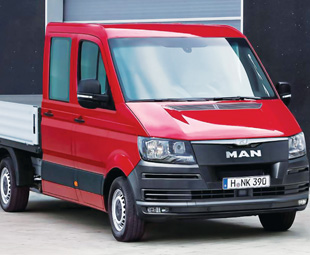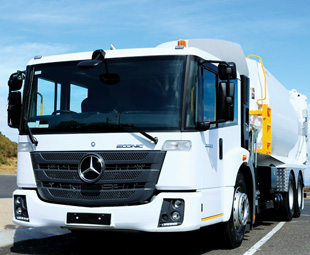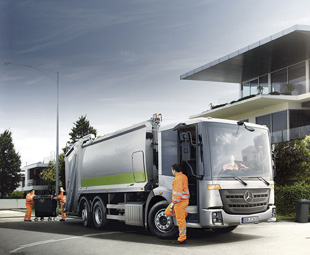MAN goes lightweight!

In his monthly review of global news for local truckers, FRANK BEETON reports on MAN’s imminent entry into the integral van market, looks at a rather strange beast that has emerged in Australia, reports on a novel new way to steer trailer axles, and details some interesting 2015 truck market comparisons.
Much has changed in the commercial vehicle world since Volkswagen (VW) and Daimler entered their cooperative “heavy van” building partnership in 1995. This collaboration has been highly successful, producing millions of vans, which have been sold in many parts of the world – including a strong push by the Mercedes-Benz Sprinter into the North American market.
However, in 2013, it was announced that the two partners were going their own way from the second half of 2016, with VW Crafter production moving from the Daimler plant at Düsseldorf, in Germany, to Września, in Poland.
Early on, it was said that Volkswagen was keen to build its own unique van in conjunction with affiliated truck manufacturer MAN, as part of its evolving strategy to expand the Group’s global commercial vehicle interests.
Last May, Volkswagen announced the formation of Volkswagen Truck and Bus GmbH as the holding division for all its commercial vehicle brands. These are made up of MAN and Scania, and include Volkswagen Caminhöes e Önibus in Brazil, and the previous joint venture with Force Motors in India – both of which are now owned by MAN.
It was noted at the time, however, that Volkswagen Commercial Vehicles, which is responsible for the Crafter van and lighter commercial models, was not taken into the Truck and Bus division.
MAN’s important announcement
During December last year, MAN Truck and Bus AG announced that it was to introduce a new light commercial range, dubbed the MAN TGE, at this year’s IAA exhibition in Hanover. This was described as a “twin” to VW’s Crafter, and is to be built alongside the parent company’s product at the plant in Poland.
 MAN says that its motivation for introducing this range will be to service its many existing customers who also operate lighter vehicles than those presently available in the MAN line-up. The TGE range is to include panel vans and chassis-cab derivatives for special body applications, with front, rear and four-wheel drive.
MAN says that its motivation for introducing this range will be to service its many existing customers who also operate lighter vehicles than those presently available in the MAN line-up. The TGE range is to include panel vans and chassis-cab derivatives for special body applications, with front, rear and four-wheel drive.
This announcement is intriguing for a number of reasons. First, it gives some clues as to the make-up of the next-generation VW Crafter, which, clearly, will be very different from the present rear-drive product, given the spectrum of drive options mentioned.
Second, it moves a van range and its derivatives firmly into the VW Truck and Bus sphere of influence, where none were positioned before.
Finally, it brings MAN into a market segment where it has not previously competed. This last factor is particularly important in the discussion about VW’s need to adjust the market positioning of its commercial vehicle brands to avoid excessive destructive competition at the upper end of the payload spectrum.
Scania and MAN’s adversarial history makes this particularly important, and the launch of the TGE series may be the first in a series of moves to make the German manufacturer less heavily dependent on heavy-duty truck business for its continuing viability.
A significant indicator
It is also important to note that VW is moving ahead with its commercial vehicle strategy at a time when it has considerable distraction from events related to the “emissions scandal”.
Early indications are that the scandal has not seriously affected VW’s light-vehicle sales performance, and there is still a good chance that it will be the global best-selling vehicle manufacturer once the final 2015 totals come in. However, nobody can accurately predict the final costs involved in addressing the scandal, but one published estimate has suggested it could be as much as $US 86 billion (R1,37 trillion)!
 VW has stated that it has no intention of selling off its trucking assets, but observers will be anxious to confirm that cash shortages do not compromise important steps that need to be taken to optimise the positioning and development of its Truck and Bus brands.
VW has stated that it has no intention of selling off its trucking assets, but observers will be anxious to confirm that cash shortages do not compromise important steps that need to be taken to optimise the positioning and development of its Truck and Bus brands.
DUAL-STEER ECONIC
Observant visitors to Australia will have noticed the rather peculiar vehicles used there for refuse collection. They invariably have steering wheels on both sides of the cab! The reason for this is the highly automated one-man-operated system of wheelie bin collection that is employed in that country.
Citizens are required to place their bins exactly on painted marks on the kerbside. The refuse compactor vehicles are equipped with side loading equipment that lifts the bin and tips its contents into the onboard hopper, before replacing it exactly on to the aforementioned mark.
To control this operation, the driver needs an unobstructed view of the bin, so he sits on the left-hand side of the vehicle while making his stop/start collection rounds. However, when transiting to and from his collection area, he moves over to the right side of the vehicle, so he can deal with traffic from the conventional driving position. Hence the need for steering wheels on both sides.
Econic joins the party
Up to now, dual-steer conversions have only been available in Australia on Iveco ACCO and Dennis Eagle products. They have now been joined by a specialised version of Mercedes-Benz’s Econic range.
This is a dedicated 4×2, 6×4 or 6×2 configuration model line-up intended for applications where a low cab profile, or ease of access, is required. This includes refuse collection (front and rear loading), road sweepers, urban deliveries, firefighting, and a number of airport duties.
The latest version of the Econic, which is based on the new-generation Actros chassis, was launched in Europe during 2013. The introduction of a dual-steer version is likely to increase its appeal on the Australian market, where it will be powered by a Euro-6 7,7-litre, six-cylinder OM 936 LA engine with an output of 220 kW (299 hp), driving through a six-speed Allison fully automatic torque converter transmission.
The Australian specification also includes full air suspension, two suspension driver’s seats, electronic stability programme, and an electronically controlled braking system.
“STEER BY BRAKE” COMES TO THE MARKET
Multi-axle bogies, or “axle units” as they are defined in South African legislation, always present some challenges in tight cornering situations. Multiple-driven axles, when placed in close proximity, rely on the differentials located in, and between, the axle aggregates to allow individual sets of wheels to rotate at different speeds, thus reducing the amount of scuffing that would otherwise result in accelerated tyre wear.
 It is quite unusual to encounter vehicles with more than two driven axles grouped together in any bogie combination, but the never-ending quest for heavier payloads (particularly in the abnormal load transport sector) has resulted in tridem axle sets – and even combinations of four or more axles – coming into play on trailers and semi-trailers.
It is quite unusual to encounter vehicles with more than two driven axles grouped together in any bogie combination, but the never-ending quest for heavier payloads (particularly in the abnormal load transport sector) has resulted in tridem axle sets – and even combinations of four or more axles – coming into play on trailers and semi-trailers.
When conventional rigid axles have been used in these applications, considerable sideways drag caused by tyre scrub has been experienced when the rig is required to take a tight corner. This has resulted in larger turning radii and high tyre wear. It can even lead to possible mechanical failure of axle and suspension components, over time and distance.
For this reason, the use of self-steering axles has become widespread, both on trailers – and even when additional non-driven axles are added to prime movers.
The current state of play
In a paper presented to the seventh International Symposium on Heavy Vehicle Weights and Dimensions held at Delft, in the Netherlands in June, 2002, Brian Jujnovich and David Cebon, of the Cambridge-based Transportation Research Group, identified three types of semi-trailer steering technologies: self-steering systems, command steer systems, and pivotal bogie systems.
In the self-steering type, the rearmost axle in the tridem bogie group is controlled by a preloaded spring and damper attached to the trailing arm. In cornering, the wheels on this axle automatically align with the direction of travel, while the spring/damper applies a self-centering force. This type of steering axle usually needs to be locked in the straight-ahead position for reversing.
In the command steer system, the steering axle or axles are “commanded” to steer through mechanical or hydraulic linkages, as determined by the articulation angle between the tractor and semi-trailer. The degree of articulation, and the amount of trailer steer input required, is measured and transmitted through either a mechanical or electronic control system.
The third type, the pivotal bogie system, has been most commonly used in extremely long semi-trailers. Typically it consists of a ball-race bearing-mounted, tri-axle bogie with fixed front axle, and two steered rear axles.
The axles progressively steer as cornering causes the angle between the bogie and trailer chassis to increase, bringing the bogie back into line with the chassis. All three of these systems theoretically reduce the wheelbase dimension of the semi-trailer, to the benefit of its cornering performance.
SBB enters the scene
While all of these systems have proved to be effective on the tridem bogie semi-trailers used most commonly for general haulage all around Europe, they do require the addition of material, unladen mass and cost to the trailer.
 German trailer manufacturer Kässbohrer GmbH unveiled its alternative solution, aimed at abnormal-load trailers with more than three axles, at the Hanover IAA show in 2014. Termed “Steer by Brake”, this concept employs conventional non-steering rigid axles, and utilises the trailer electronic braking system (TEBS) to brake the rearmost inner wheel during cornering.
German trailer manufacturer Kässbohrer GmbH unveiled its alternative solution, aimed at abnormal-load trailers with more than three axles, at the Hanover IAA show in 2014. Termed “Steer by Brake”, this concept employs conventional non-steering rigid axles, and utilises the trailer electronic braking system (TEBS) to brake the rearmost inner wheel during cornering.
This action is claimed to have a similar wheelbase-shortening effect to that provided by a self-steering axle. The TEBS technology also configures the trailer’s air suspension system for the desired legislated turning radius when the combination enters a tight turn at low speed.
The Steer by Brake system has been developed by Kässbohrer in conjunction with braking specialist Knorr-Bremse. With commercial availability set for May 2016, its claimed benefits include: the elimination of complex self-steering operation, elimination of the requirement to lock axles when reversing, and lower total cost of ownership after the combination of initial investment, tyre wear and maintenance are considered.
We have noted that this system is being touted specifically for heavy-load, multiple-axle trailers. This leads us to believe that it may not be as cost-effective in high-speed applications using tridem bogies, given the greater influence of fuel consumption and tyre costs on the operational economics in that area of activity.
It will be interesting to follow its progress, and to see if it migrates into more general haulage usage at a later date.
2015 MARKET COMPARISONS
Once the December sales returns had been audited, the South African market for commercial vehicles over 3 500 kg gross vehicle mass (GVM), generally known as the “truck market”, finished the full 2015 calendar year with total reported sales of 30 535 units.
This was some 3,2 percent off the 2014 total of 31 558 units, but was generally considered to be a positive result – considering the challenging economic climate prevailing in the country, and its main trading partners, throughout the year.
However, it is important to note that the volumes quoted include estimates by the National Association of Automobile Manufacturers of South Africa (Naamsa) of sales volumes for Daimler Truck and Bus’s Mercedes-Benz, Freightliner and Fuso models; as that grouping has continued to report only aggregated data divided into total passenger and commercial unit sales since November 2014.
The unfortunate withholding of detailed data, by such an important participant in the market, makes the accurate determination of overall market and segment sizes impossible.
Aussie reportback
Nevertheless, the data provided by Naamsa is the best available, and the only measure we have to compare the local market with offshore equivalents. As we have stated many times before, the Australian truck market is probably more similar, in both size and composition, to our own equivalent than any other, making comparisons valuable.
 During 2015, the total number of trucks and large vans sold in Australia amounted to 32 003 units, which improved on the equivalent 2014 year total by a margin of 4,5 percent (this total excludes bus deliveries, which numbered 1 355 units over the same twelve-month period).
During 2015, the total number of trucks and large vans sold in Australia amounted to 32 003 units, which improved on the equivalent 2014 year total by a margin of 4,5 percent (this total excludes bus deliveries, which numbered 1 355 units over the same twelve-month period).
Of the segments making up the market, heavy-duty trucks (over 39-t gross combination mass) totalled 9 895 units; light trucks (3,5 to eight tonnes GVM) recorded 9 868 units; medium-duty trucks (eight tonnes GVM to 39 t GCM) finished on 6 725 units; and vans (3,5 to eight tonnes GVM) recorded 5 515 units.
Australian commentators noted that the lower payload categories had experienced healthy sales during the year, while heavy-duty sales were down 25,8 percent from their performance in the peak year of 2007, with this premium payload segment falling to 31 percent share of the total market from a reported highpoint of 37 percent three years back.
During December 2015, Volvo (184 unit sales) finished ahead of perennial heavy-duty segment leader Kenworth (153 unit sales), this being the first time in many years that Kenworth has been displaced from the premier position. The other Swedish heavy truck manufacturer, Scania, also finished the year on a high note with 132 unit sales in December.
In the overall 2015 market, Isuzu remained the top seller, capturing a 23,3 percent share, followed by Hino with 13,9 percent and Mitsubishi Fuso with 10,8 percent. Isuzu led both the light and medium truck segments, with shares of 35,4 percent and 40,8 percent respectively. In the heavy-duty category, Kenworth maintained top spot over the whole year with 20,4 percent segment share, ahead of Volvo with 14,9 percent and Isuzu with 12,2 percent.
Mercedes-Benz retained leadership of the van category with 43 percent share, but a growing challenge was mounted by Renault with 24,7 percent share.
Slices of the (big) American pie
The United States market is, of course, an entirely different kettle of fish. Total Class 4 to 8 sales, which cover the GVM spectrum upwards from 6 364 kg, finished 2015 at no less than 449 458 units.
This improved on the equivalent 2014 outcome by 10,5 percent of the individual market categories, Class 8 (above 15 000 kg GVM) increased by 12,9 percent; Class 7 (11 818 to 15 000 kg GVM) improved by 8,7 percent; Class 6 (8 864 to 11 818 kg GVM) grew by 6,6 percent; Class 5 (7 273 to 8 864 kg) improved by 7,8 percent and Class 4 (6 364 to 7 273 kg GVM) increased by 7,4 percent.
The vast volume opportunity offered by this market explains why major truck manufacturers remain prepared to continue building the unique types of products demanded by the overwhelming majority of American operators and drivers – including bonneted (conventional) premium prime movers, and petrol-engined light and medium payload models – while there is only a limited demand for these vehicle types elsewhere in the world.
Global FOCUS is a monthly update of international news relating to the commercial vehicle industry. It is compiled exclusively for FOCUS by Frank Beeton of Econometrix.
Published by
Focus on Transport
focusmagsa




